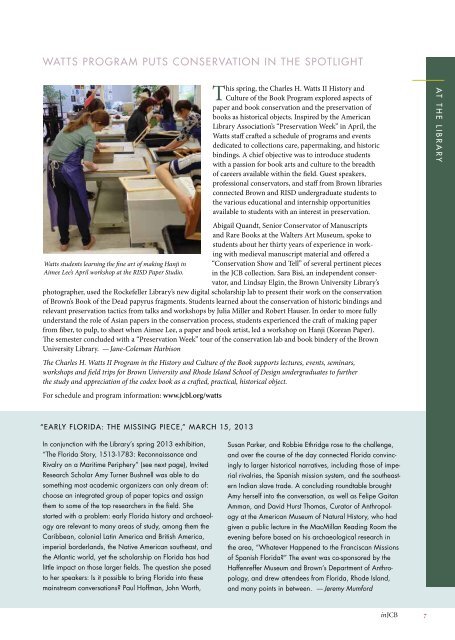You also want an ePaper? Increase the reach of your titles
YUMPU automatically turns print PDFs into web optimized ePapers that Google loves.
WATTS PROGRAM PUTS CONSERVATION IN THE SPOTLIGHT<br />
This spring, the Charles H. Watts II History and<br />
Culture of the Book Program explored aspects of<br />
paper and book conservation and the preservation of<br />
books as historical objects. <strong>In</strong>spired by the American<br />
Library Association’s “Preservation Week” in April, the<br />
Watts staff crafted a schedule of programs and events<br />
dedicated to collections care, papermaking, and historic<br />
bindings. A chief objective was to introduce students<br />
with a passion for book arts and culture to the breadth<br />
of careers available within the field. Guest speakers,<br />
professional conservators, and staff from <strong>Brown</strong> libraries<br />
connected <strong>Brown</strong> and RISD undergraduate students to<br />
the various educational and internship opportunities<br />
available to students with an interest in preservation.<br />
at the library<br />
Watts students learning the fine art of making Hanji in<br />
Aimee Lee’s April workshop at the RISD Paper Studio.<br />
Abigail Quandt, Senior Conservator of Manuscripts<br />
and Rare Books at the Walters Art Museum, spoke to<br />
students about her thirty years of experience in working<br />
with medieval manuscript material and offered a<br />
“Conservation Show and Tell” of several pertinent pieces<br />
in the <strong>JCB</strong> collection. Sara Bisi, an independent conservator,<br />
and Lindsay Elgin, the <strong>Brown</strong> <strong>University</strong> Library’s<br />
photographer, used the Rockefeller Library’s new digital scholarship lab to present their work on the conservation<br />
of <strong>Brown</strong>’s Book of the Dead papyrus fragments. Students learned about the conservation of historic bindings and<br />
relevant preservation tactics from talks and workshops by Julia Miller and Robert Hauser. <strong>In</strong> order to more fully<br />
understand the role of Asian papers in the conservation process, students experienced the craft of making paper<br />
from fiber, to pulp, to sheet when Aimee Lee, a paper and book artist, led a workshop on Hanji (Korean Paper).<br />
The semester concluded with a “Preservation Week” tour of the conservation lab and book bindery of the <strong>Brown</strong><br />
<strong>University</strong> Library. — Jane-Coleman Harbison<br />
The Charles H. Watts II Program in the History and Culture of the Book supports lectures, events, seminars,<br />
workshops and field trips for <strong>Brown</strong> <strong>University</strong> and Rhode Island School of Design undergraduates to further<br />
the study and appreciation of the codex book as a crafted, practical, historical object.<br />
For schedule and program information: www.jcbl.org/watts<br />
“EARLY FLORIDA: THE MISSING PIECE,” MARCH 15, 2013<br />
<strong>In</strong> conjunction with the Library’s spring 2013 exhibition,<br />
“The Florida Story, 1513-1783: Reconnaissance and<br />
Rivalry on a Maritime Periphery” (see next page), <strong>In</strong>vited<br />
Research Scholar Amy Turner Bushnell was able to do<br />
something most academic organizers can only dream of:<br />
choose an integrated group of paper topics and assign<br />
them to some of the top researchers in the field. She<br />
started with a problem: early Florida history and archaeology<br />
are relevant to many areas of study, among them the<br />
Caribbean, colonial Latin America and British America,<br />
imperial borderlands, the Native American southeast, and<br />
the Atlantic world, yet the scholarship on Florida has had<br />
little impact on those larger fields. The question she posed<br />
to her speakers: Is it possible to bring Florida into these<br />
mainstream conversations? Paul Hoffman, John Worth,<br />
Susan Parker, and Robbie Ethridge rose to the challenge,<br />
and over the course of the day connected Florida convincingly<br />
to larger historical narratives, including those of imperial<br />
rivalries, the Spanish mission system, and the southeastern<br />
<strong>In</strong>dian slave trade. A concluding roundtable brought<br />
Amy herself into the conversation, as well as Felipe Gaitan<br />
Amman, and David Hurst Thomas, Curator of Anthropology<br />
at the American Museum of Natural History, who had<br />
given a public lecture in the MacMillan Reading Room the<br />
evening before based on his archaeological research in<br />
the area, “Whatever Happened to the Franciscan Missions<br />
of Spanish Florida?” The event was co-sponsored by the<br />
Haffenreffer Museum and <strong>Brown</strong>’s Department of Anthropology,<br />
and drew attendees from Florida, Rhode Island,<br />
and many points in between. — Jeremy Mumford<br />
in<strong>JCB</strong> 7
















